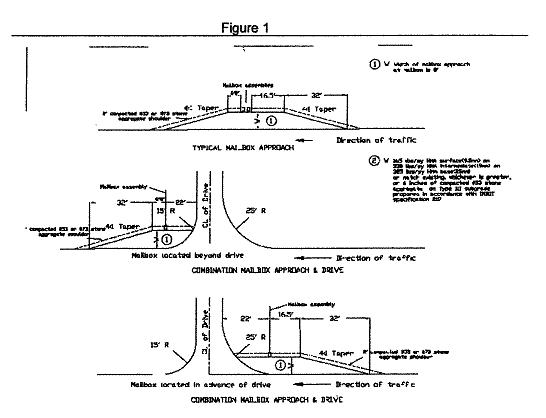(A) Approaches are designated as belonging to one of the following five classes.
Approach Class | Type of Approach | Features |
Class I | Private approach | Raised curb |
Class II | Private approach | Shoulder only, no raised curb |
Class III | Commercial approach | Raised curb |
Class IV | Commercial approach | Shoulder only, no raised curb |
Class V | Field approach | Compacted aggregate surface |
(B) The location for a Class I approach is usually in an urban area. The approach characteristics are constructed so that it is located on a roadway bordered by curbs, and serves a private residence and improved property. A hard pavement surface, curbs, enclosed drainage such as storm sewers, and sidewalks are common elements in the construction of this approach.
(C) The location for a Class II approach is usually in a rural area. The approach characteristics are constructed so that it is attached to the edge of the county road pavement or improved hard surface shoulder and serves private residences and improved property. A pipe continuing drainage along the county road ditch line is a required element in the construction of this approach, unless a variance is approved by the County Engineer.
(D) The location for a Class III approach is usually in an urban area. The approach characteristics are constructed so that it is located on a roadway bordered by curbs and serves a commercial establishment. A hard pavement surface, curbs, enclosed drainage such as storm sewers, auxiliary lanes, tapers, and sidewalks are common elements in the construction of this approach.
(E) The location for a Class IV approach is usually in a rural area. The approach characteristics are constructed so that it is attached to the county road edge of pavement and serves a commercial establishment. A hard pavement surface, auxiliary lanes, and tapers are common elements in the construction of these approaches. A pipe continuing drainage along the county road ditch line is a required element in the construction of these approaches, unless a variance is approved by the County Engineer.
(1) Approach edges for Class IV commercial minor driveway approaches shall be connected to either tapers of a short auxiliary lane or to the county road traveled way pavement with returns of adequate radii.
(2) Tapers which improve the ingress and egress turning movement characteristics of the approach and which connect the radii returns to the county road traveled way pavements are required when either of the following criteria are met: (Counts must be collected or approved by the County Engineer.)
(a) The highway ADT is greater than 3,000 vehicles per day; or
(b) The approach ADT is greater than 40 vehicles per day.
(3) Tapers will not be required for those commercial drives whose conditions will not exceed the criteria of subsections (a) and (b) above. In these instances, approach edges may be connected to the highway traveled way with returns of radii only.
(F) The location for a Class V approach is either in an urban or rural area. The main characteristics are that it serves a vacant lot, field, or unimproved property and draws only an occasional vehicle and is typically not a permanent drive. A graded, compacted aggregate surface and a pipe continuing drainage along the highway ditch line are required elements in the construction of this approach, unless a variance is approved by the County Engineer.
(G) (1) All classes of approaches, except Class V, shall install a mailbox approach in compliance with Figure 1 when the following conditions are met:
(a) The existing road has mailbox approaches.
(b) The existing road has adequate shoulder area in the public right-of-way.
(2) The construction cost associated with the mailbox approach shall be included in the amount of the bond for the driveway approach.
(3) The location of the mailbox approach shall be determined by the U.S. Postal Service.

(Ord. 1999-6E, passed 6-28-99; Am. Ord. 2005-11E, passed 11-28-05)